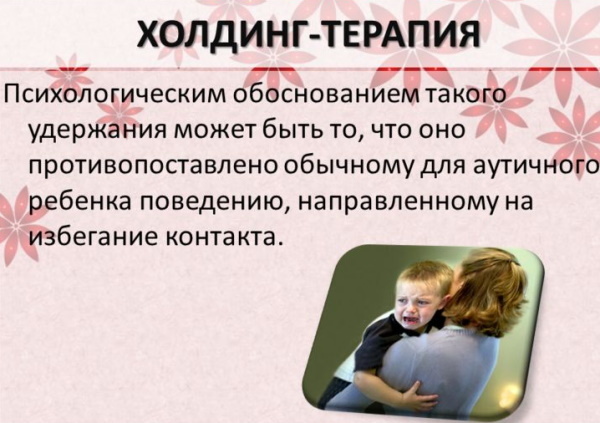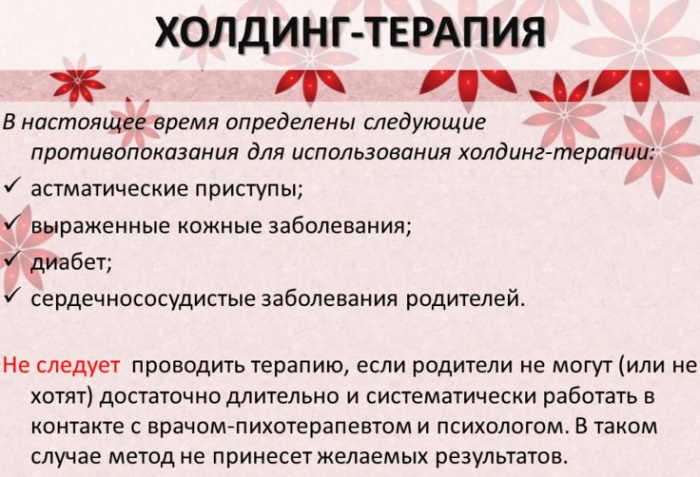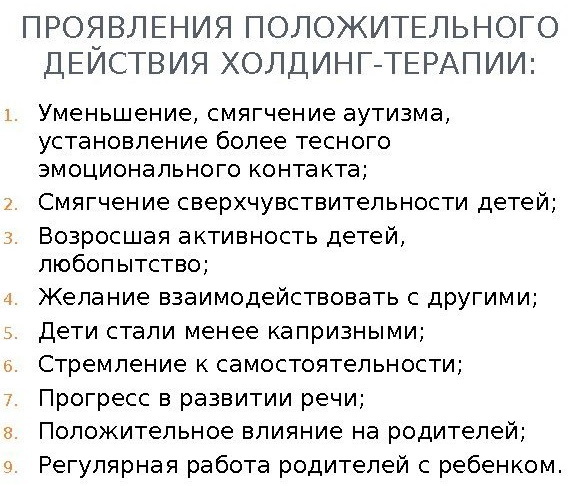Content
- Definition of holding therapy
- Goals and objectives of treatment
- Contraindications to holding therapy
- What is needed for treatment
- Which specialist performs the treatment
- Stages of holding therapy for children with autism
- Confrontation
- Rejection
- Permission
- Rules of conduct
- What you can do in cuddle therapy
- Child's reaction to holding therapy
- Video about holding therapy
Today, holding therapy is actively used to treat children suffering from autism. According to the name of the technique, the condition is relieved by hugging. It is well known that it is extremely difficult for autistic children to find contact with their parents. But in the course of holding therapy, I manage to get closer and solve some psychological problems. There are many critics of such treatment, who explain their position by the fact that the technique is aggressive towards the patient.
Definition of holding therapy
Holding therapy is a technique that aims to create tactile contact between an autistic child and his or her parents. It is believed that in this way it is possible to form the so-called bases of emotional attachment. Its essence lies in the fact that the mother or father should forcibly hug the child until he stops resisting and begins to take such events calmly.
The author of this technique, who compiled the most accessible course, is M. Welsh. In Russia, the effectiveness of such exercises has also been officially confirmed. Psychophysiology claims that holding therapy can significantly alleviate the autistic condition and teach him to establish visual and psychophysical contact with his father and mother.
Goals and objectives of treatment
Back in 1983 g. a psychiatrist named Martha Welch began working on the creation of holding therapy. The main goal at that time was to restore emotional contact between the child with autism and his parents. However, already at that time, the concept was rather controversial.
It seemed that the parents themselves were to blame for the child's health problems. This awareness was imposed on the father and mother. According to this concept, it was considered that emotional disorders in a child are caused precisely by the fault of the parents. As a consequence, an emotional communication failure occurs.
Since a child's attachment to their parents is formed primarily through a sense of security, it is very difficult for children with autism to cross this barrier. Martha believed that children with autism were unable to trust their parents or feel the same feelings as other children.
Also, with such a diagnosis, social as well as emotional development is disturbed, which is formed in a completely wrong way. An autistic child is not able to look the parent in the eyes, cannot properly hug and interact with him. Accordingly, holding therapy allows you to create forced stress, which helps to overcome the autistic barrier. This allows the child to quickly begin to feel calm and learn to communicate with the father and mother.
Martha's followers developed her theory and also tended to believe that early autism in a child can occur even if he was adversely influenced by the environment. They don't have to be parents. However, the child loses confidence and a sense of security even if there is no subsequent pressure on him. In fact, such patients are not able to correctly build their reactions.
Many experts believe that autistic children simply cannot develop even basic trust on their own. These patients experience severe hostility. They seem to be constantly trying to resist their surroundings.
Holding therapy for children aims to show the child (teach him on an instinctive level) that the people around him do not want to harm him. The methods of interaction of foreign specialists are a little more aggressive than those of those who develop a similar direction in Russian psychology.
For example, Maria Liebling offers a softer method of restraint compared to classical holding therapy. In collaboration with other psychologists, Maria developed a slightly different explanation of the goals of this technique. Treatment is aimed at overcoming the autism barrier. However, the procedure is more "cleansing", that is, it allows you to relieve emotional stress, as well as negativity.
In addition, Liebling aims to develop new forms of emotional interaction between parents and children with disabilities. In contrast to the classical holding therapy, Maria proposes to focus more on the developmental components.
The tasks of a specialist psychologist who conducts the exercises include:
- Teaching parents how to properly interact with a child who has been diagnosed with this.
- Teaching the father and mother methods that will further teach the child to imitate, and then use some skills on their own.
- Correctly develop the child's ability to empathize.
Contraindications to holding therapy
There are many works that critically describe such interactions with children with autism. Some critics of the treatment call it a shock treatment and argue that it only has a negative effect on the condition of patients. It is believed that a child during such events is not aware of what is happening, but only thinks that they want to harm him. Holding therapy can be perceived as a punishment at all, it causes serious discomfort for the child and even pain.
Experts fear that the child may become depressed in the future. This cannot in any way have a positive effect on the formation of normal relations with parents. After such classes, especially if they were conducted by an unqualified specialist, the opposite effect appears. That is, the child begins to show more and more feelings of anxiety.
Most psychologists identify only a few official contraindications to exercise.
Holding therapy is contraindicated if:
- the child has a tendency to epileptic seizures;
- a parent or child has a serious illness, the exacerbation of which can occur directly during exercise;
- the child's father cannot be involved in the therapy. This is due to the fact that it is too difficult to withstand such exercises with increased stress alone. The psychologist, in turn, should never take the place of one of the parents.
Such events cannot be carried out if the parents understand that they are not ready from a psychological point of view to cope with the conditions. You also need to refuse treatment if the child is overexcited, in a stressful state.
What is needed for treatment
Holding therapy for children should be carried out according to the rules:
- It is necessary to prepare for the procedure, which can last up to 4-5 hours.
- In the course of treatment, it will be necessary to correctly and consistently carry out actions.
- It is important to realize that the main goal of the exercise is, through stress and subsequent relaxation, to try to break the psycho-emotional barrier between the parent and the child with autism.
The preparatory stage is very important, otherwise the result will not be achieved. During classes, the child may begin to resist, behave aggressively, and scream.
For treatment, you need to take a comfortable position, therefore, you need to prepare a comfortable chair or chair on which you can sit for a long time with the child in your arms. You will also need toys, books with fairy tales, and any other items that soothe children. They may be needed if the patient begins to strongly resist and behave aggressively.
Which specialist performs the treatment
The exercises are conducted by a pediatric neuropsychiatrist. He must explain to the parents how they should behave in order to achieve contact with the child.
The neuropsychiatrist can carry out various therapeutic procedures:
| Treatment type | Brief description |
| Psychotherapeutic conversation | Allows you to identify problems. During the conversation, there is a strong emotional discharge of the patient. After the sessions, he feels much better and gets rid of the depressive state. |
| Introspection | The neuropsychologist asks the patient questions that allow the person to understand the reasons that led him to the appearance of psychological problems and physical discomfort. |
| Hypnosis | A qualified neuropsychiatrist can, by introducing hypnosis, relieve a patient from depression, panic attacks, obsessive thoughts and much more. |
| Drug treatment | A specialist may prescribe a variety of remedies that can help relieve complex symptoms. A neuropsychiatrist may prescribe synthetic or herbal medicines. |
| Psychotherapeutic techniques | The neuropsychologist can choose from a variety of techniques that, in his opinion, can have the best effect. For example, he conducts classes in art therapy, music therapy, holding therapy. |
Stages of holding therapy for children with autism
There are three generally accepted stages that are important to go through during the exercise.
Confrontation
This is the very initial period when the child is very actively opposed to the procedure. It is noteworthy that from the outside it seems as if the child is experiencing serious inconvenience. But after the first session, there is a feeling that he expects the next such contact with the parent. However, when starting the next session, he may become very nervous again.
Rejection
This stage is also called resistance. It is no longer about the emotional, but the physical behavior of the child, who may begin to bite, scratch and fight with the mother who hugs him. If this happens, then at this stage the child's father must join the process. For example, pat him on the head, back with very light movements and try to calm him down.
If this happens, then at this stage the child's father must join the process. For example, pat him on the head, back with very light movements and try to calm him down.
Permission
Holding therapy is successful when it becomes easier for children to be around their parents. This is the final stage of treatment. In the course of it, the child completely ceases to resist. It can be admitted that permission has come when eye contact is made with the parent. At such a moment, the child usually relaxes and may even smile.
Changes in behavior can be noted by the changed posture. If the child begins to look with interest the face of the mother and father, as if he is seeing them for the first time, then this is considered a very good result. At this stage, it is important to maintain the effect of the treatment. To do this, parents must continue to talk to the child and be sure to tell him how much they love him, that such events are simply necessary to make him feel better.
The duration of the first session can take up to 4.5 hours. Gradually, it takes less and less time before the resolution phase. Starting from the second lesson, the procedure rarely lasts more than 2 hours.
Rules of conduct
Exercises are carried out as follows:
- The mother takes the child in her arms, hugs and hugs him. Most likely, in this situation, the autistic patient will try to free himself.
- The mother tries to calm the child down with gentle words. At the same time, it is important to speak softly and calmly about how she loves him and that he means a lot to her.
- Holding the child continues until he relaxes and begins to show a lack of fear. Ultimately, he should completely calm down and snuggle up to his mother.
The patient's father during the session helps the mother and morally supports her in every possible way. He should speak to the child in a very quiet and calm voice. We should try to explain to him that such treatment is very important.

After a few such sessions, the task becomes more difficult. The mother of the child should try to teach him to look her directly in the eyes. As soon as eye contact is established, it is necessary to start talking to the child. It will not be superfluous to tell rhymes and sing songs or just say something in an affectionate voice.
Although at first it seems that there will be no result, after a few sessions, children with autism show a positive reaction. After the parents learn how to properly conduct holding therapy, they can independently (without the supervision of a specialist) perform such exercises at home. This can be very helpful in situations where children become overly anxious.
There is another description of the process that is also used during therapy:
- The mother sits in a comfortable position and puts the child on her lap so that their faces are on the same level.
- The baby's legs wrap around the mother's waist, and she, in turn, hugs him around his back.
- For several minutes, a rather strong psychoemotional reaction occurs on the part of the child. An important task for a mother is not to give in to her emotions.
Despite the fact that the child is trying to escape from the embrace, you need to try to keep him anyway. Accordingly, this will require the use of physical force. Without this, it is impossible to ensure closer contact.
It is impossible to interrupt therapy at the moment when the child begins to resist. It is important to ensure that the patient is completely relaxed and begins to feel a sense of security. For the first few weeks, and sometimes months, children with autism have serious psychological anxiety because they do not understand what such exercises are for. During this period, it is impossible to interrupt therapy, no matter how hard it is for the parents.
Sometimes the resolution phase does not come at the very end. During the session, the child can resist and relax several times. When the patient has relaxed, it is necessary to learn to understand this. Over time, the mother learns to control the baby's stress. It is at such moments that it is even required to insist that the child carefully look at the mother and listen to her. While this will cause a more violent reaction, the end result will be much better.
When it is possible to establish good contact with the mother, the father can start working with the child. In this case, he should already hug the child. Over time, you can teach your child to communicate. It is important that he, too, is involved in the conversation and tells how he feels, what he would like to do, what fantasies he has. The more cognitive the exercises are, the more closeness can be achieved.
What you can do in cuddle therapy
Holding therapy for children is a treatment during which you can:
- Learn poetry, act out different scenes. For example, you can show your child the games "over bumps", "rails-rails" and other fun games.
- Consider photographs, interesting pictures.
- Fooling around, making faces.
- Learn to count on your fingers.
- Show the cards to the child. You can complicate the task, for example, ask him to point his finger at a certain object, animal or person.
- Learn syllables and new words. After eye contact has been established, you can ask the child to repeat after mom.
- Massage or light rubbing.
- Hug and hide under the covers. This allows for a better bond with the parent. However, such activities are permissible only if the child is already accustomed to therapy.
- Make plans for the future, tell the child how well his future will be.
- Remember funny experiences from the past.
Child's reaction to holding therapy
Often, initially, the child behaves rather aggressively and does not perceive the parents properly. However, later he begins to relax and with each subsequent lesson, a better result is observed.
If the exercises were carried out correctly, then they will be effective and will allow you to maintain the received contact with the child in the future. If the parents are not mentally ready for such difficult events, they risk interrupting the procedure ahead of time.
This is fraught with very serious consequences. If the child does not reach a state of relaxation and trust in the parent, then all subsequent manipulations will be perceived by him more aggressively. He will begin to see in the parents those people who only want to harm him. Therefore, if the father and mother are not sure that they are psychologically not ready, then it is better to refuse treatment altogether.
Modern holding therapy can seem traumatic for children. In this case, you can try a less complex treatment first. For example, some parents prefer fairy tale therapy, music therapy, and many other methods of alleviating the condition of a child with autism.
Video about holding therapy
Pros and cons of holding therapy for autism:



